Artist James Paterson and his wife Lynn live in Meaford, Ontario, on the southern shore of Georgian Bay, tucked into Lake Huron. James creates art that is both beautiful and stimulating, celebrating mystery while igniting our imagination.
We recently had a delightful, rambling conversation with James about his life, his art, and what makes him curious. Here are some highlights from that conversation – but first a video clip from an episode of Space Channel’s flagship show InnerSpace, which featured host Teddy Wilson visiting James and his Prayer Machines at Toronto’s Petroff Gallery.
(2:47)
Kolbe Times: Your amazing Prayer Machines totally invoke curiosity and childlike wonder. Were the seeds of all this creativity planted during your childhood?
James Paterson: Probably. I think I had a very interesting childhood. My parents ran an inner city mission in Toronto called St. Stephen’s Community House, in the Kensington Market area. It started out as an Anglican Evangelistic Mission to the Jews called the Nathaniel Institute. My dad was hired on as the “Boys’ Worker” in the late 1950s. The neighbourhood was transitioning at that time, and so instead of being specifically an outreach mission to the Jews, the Nathaniel Institute was becoming a ministry helping all the immigrants who were starting to come into that part of the city at the time – the Portuguese and eastern Europeans and others. They changed the name to St. Stephen’s, and my dad became the Director. So that’s where my family lived – right in Kensington Market. And you know, looking back, it felt like a world of wonder, this “new world” setting into which people with “old world” sensibilities were arriving from so many different countries.
There were people in the Community House all the time. We lived in an apartment upstairs, and on the main floor there were all these other rooms, with a gymnasium attached. People just came and went – there were English classes during the day for new Canadians and then there was all sorts of after-school and evening activities for kids and young adults and older people. I remember lying in bed at night and listening to all these things going on beneath me. There was a group of Portuguese folk dancers that would practice in the gymnasium on Thursday nights, I remember, and they danced in their bare feet and some of them played instruments. It was quite magical to me to be always hearing things like that, but of course as a kid I didn’t think of it as anything other than normal.
And right up the street from St. Stephen’s Community House was an Anglican Church called St. Stephen’s in the Fields that we were connected with. I was an altar boy there and then sang in the choir – and that was all kind of magical, too. The minister who served there when I was young, well, he wasn’t exactly eccentric but let’s just say he was a bit flamboyant. He really loved processions, and he would have processions around the church for any reason at all. I remember carrying the cross at the head of the procession, and we’d go out one door at the side of the church and walk outside around the end of the building and come in another door. There were a lot of Jamaican immigrants who attended the church, and many of the Jamaican ladies sang in the choir, too. So there I was, this little white blonde boy singing alongside them. They were always so joyful, and I vividly remember that they seemed to always be hugging everyone, including me. So my experience at church was actually a lot of fun, as I look back on it – a real slice of charismatic humanity. And yet there was also this very rich liturgy as well.
Kolbe Times: What led you into art?
James Paterson: It might sound a bit cliché, but as a kid I was always making things with my hands. I liked painting and drawing too, but I always really loved making plastic models; you know, cars and airplanes. And I remember combining them in different ways, not following the plans but sort of sticking them together in new ways so they’d look how I wanted them to look. And reflecting back, I realize that’s basically what I’m still doing now, as I make these Prayer Machines.
But when I was in high school we moved to a small rural town in southern Ontario. My Dad changed jobs and became a Christian Education Director for a United Church. That move was actually kind of traumatic for me, moving from a big city into the country. But that’s where I started getting really interested in art. Instead of doing my homework at night, I’d have all these art projects on the go. And then in grade 12 I needed an extra credit so I took Grade 9 Art, and discovered I just loved it. Over the course of that year the art teacher bumped me through the Grade 9, 10, 11 and 12 courses. In in the summer I took the Grade 13 course by correspondence, and then started a Fine Arts degree at the University of Waterloo.
Kolbe Times: And that led to a career as an art teacher.
James Paterson: Yes, and how that came about was a really neat thing, too. After I graduated, I soon realized that alongside doing art I needed a job! And then I heard about this Christian School that had just started, and someone mentioned I should apply there. So I did…and I got hired! The principal told me later that he had this stack of resumes on his desk, but mine stood out because it was handwritten, and I had included an illustration of myself holding a can of paint and a brush. So anyways, this was the second year that this Christian School was going, and they were really growing in size. I actually started and designed the Art program there. My wife Lynn taught there as well.
Kolbe Times: In 1988 you left teaching to pursue art full time. Tell us a bit about that time in your life.
James Paterson: Well, there was a point when I was coming home after school every night and just painting the whole evening, and I started thinking I don’t want to get to be 65 with a pension and wonder if I could have made it as an artist. In 1987 my wife Lynn and I took a leave of absence from the school for six months. We travelled all over the world, and ended up in L’Abri in England. (L’Abri Communities, founded in 1955 by Francis Schaeffer, are Christian Study Centres now located in many countries around the world.)
We spent three months there. At that point we’d only been married for three or four years, and were starting to think about having children. Lynn was Mennonite and I was Anglican, so we wanted to look at the whole baptism issue, plus there were lots of other issues we were exploring. I was looking into art, from a Christian perspective. While we were away, a new principal was hired at the school, and I just had a sort of feeling that this might be a good opportunity to make a break. I taught one more year until June of 1988, and Lynn stayed on until January of the next year, and then our first child was born.
Kolbe Times: That must have been an exciting time, but also a bit scary.
James Paterson: It was probably more scary for our parents than us! On one hand, we didn’t really know what we were doing, and ignorance is bliss. But we were also pretty eager young Christians, and we had a lot of faith that we were doing the right thing, somehow.
Kolbe Times: When did you start creating your Prayer Machines, and how did the idea come about?
James Paterson: In 2008 I was starting to feel restless. I loved doing my art, but I’d been at it for 20 years full time and I just wanted a break – maybe take a year off and volunteer with my family somewhere in the world. Nothing really seemed to work out so we put the idea aside, but when I was exhibiting some of my art at a Mission Fest, a woman came to my booth who was representing the Black Forest Academy, a Christian Boarding School in Germany for children of missionaries working in Asia, northern Africa and Europe. We met this woman on Thursday night, and by Monday morning we were applying to teach at her school in Germany.
They wrote back and said they didn’t need any teachers, but would we consider dorm parenting. We wrote back and said, “What’s that? We don’t even know what that is.” They sent us back a job description. I remember specifically reading it on the computer and Lynn looking over my shoulder and saying, “We could do that! That’s us!”
So, long story short, we ended up in September 2008 over in Germany in a school dorm with 22 teenage daughters. We took our two youngest kids with us – one was in grade 7 and one in grade 10. Our two oldest boys didn’t come with us because they were starting college and working.
But because of the upheaval in our lives, I ended up having a bit of a crisis that year. I’d gotten used to working on my own for a long time, and here I was suddenly working as part of this larger team, with a boss, and we were responsible for all these girls. There was a lot of structure in all that, and with the cultural shift as well, plus the fact that I was just tired … well, I had a breakdown. I found I couldn’t pray. I couldn’t say a word to God. As I worked through that, I started thinking about how I was more visual than verbal. I started wondering, “What would my prayers look like?” And I literally just started playing with wire.
I began picking up pieces of wire and coat hangers and twisting them. Some carpenters were doing some renovations in our dorm at the time, and there were these scrap blocks of wood just lying around. I started sticking wire into these blocks, as stands. And my prayer life returned. It was the most amazing thing. I called these little creations my Prayer Machines, and then the artist in me sort of took over and I started developing them more as art pieces. Then people around the school started wanting them! That was the genesis.
Kolbe Times: The Prayer Machines have evolved in different ways over years. I guess that’s probably been in response to your own unfolding life experiences.
James Paterson: Recently I’ve been reading Oliver Sacks and some of his stuff on creativity. He talks about how you take in all these influences as you see the world and pass through it. You let them deep into your unconscious where they ferment and gestate, and in time they come out again, but through the filters of who you are. Artists essentially create new ideas from all of those past influences. What I see happening with the Prayer Machines is that they started in one place, which was my need to learn how to pray again, but then they soon went beyond that. Now, all these other elements of my life and childhood are starting to come to the surface. I’m beginning to realize that I can tell my own story, using my voice, through this medium that I created.
Now my Prayer Machines are veering off into different series, which I’m actually naming – in the same way that cars have different models and names. For instance, there are these big floor-standing Prayer Machines that are quite spectacular, which I call “The Weight of Glory” series. It’s about what would you do with your imagination if there were no constraints. Then there’s another group that are more like two dimensional wall pieces that I call the “Bellevue” series. The name of the street where I grew up in Kensington Market was Bellevue Avenue, so this series is very autobiographical. They reflect the colors and shapes and the sounds and the noises I remember from my childhood. Probably my favourite is the “Carnival” series. These ones stand for the most part on a wooden base, and can sit on a shelf. They’re just very free, with lots of moving parts. The Carnival series is very much about a sense of wonder and joy. In the Carnival series pieces, I’ll often include a piece of tightrope with someone walking on it, representing how, as Christians, we’re not just called to walk that fine line of the tightrope and stay safe – we’re actually called to dance on it! There’s another series of little pieces, very inexpensive, called “Just a Thought”.
I put titles on each piece that ask questions and make comments. I was delivering some pieces to a gallery the other day, and the woman at the gallery was so glad that I’ve started writing the titles on the bottoms of each piece now. She said, “Oh, that’s good, because that’s the reason people are buying them – because of the titles.”
Kolbe Times: Your art seems to come with an open invitation to touch and explore and reflect.
James Paterson: One of the funniest things I’ve observed about my pieces, especially the ones with moving parts, is that I always tell people to go ahead and touch, get right in, look closely, turn the crank – and they say, “No, I can’t.” And I say, “Of course you can!” “And they almost always say, “No…I might break it.” It just shows you how we’ve all been conditioned to think that we shouldn’t touch art. But my pieces are all about relationship. That’s why for the most part I put a crank in there, so that you have to touch it – otherwise you won’t get the full effect. In the same way, if you don’t really get to know people, if you don’t fully embrace them for who they are, then you don’t get the full effect of seeing who God created them to be.
There’s also an ambiguity that I try to infuse into my Prayer Machines. I want people to bring their own story to each piece. Invariably they can see things in them that I didn’t even intend, or don’t see myself. I get a lot of delight in seeing and hearing people’s reactions, because I’m curious about what’s going on in their lives.
Kolbe Times: You wrote in your latest blog that your Prayer Machines have made you “curious about what machines are, where they’ve come from, and where they are going”, and that you’re very interested in the evolving relationship between machines and humans. Can you talk a little about the direction your curiosity seems to be taking you?
James Paterson: I’ve always been interested in cars, and I’ve been reading and thinking a lot about the rise of autonomous vehicles, and the effects that they say they’re going to have on us – not just on our lives personally, but also the social change that’s going to come about because of them. I grew up in a time when, starting in the late 1950s, they got a lot of the problems worked out with cars. Essentially, they were pretty good, and then they began to make them as art pieces – you know, those beautiful cars from the 50s, 60s and 70s, when they were really objects of desire. And then we went beyond that and started making cars that were much more efficient and economical.
I find it really fascinating that one of the things we most identified with cars back in those early days is the freedom they brought us. You could get into a car and go almost anywhere you wanted to go – on your own. It was almost like science fiction come to life, this idea of going for a Sunday drive, or cruising around town on Friday night looking for friends. Our society was built around the car, with the highway system leading to the suburbs, and of course driving to the mall to go shopping. But with autonomous vehicles, instead of us taking the car out for a drive, the car is going to be taking us out for a drive. But what if you want to go for a drive, just meandering by yourself? Or what if the vehicle has been programmed not to go to certain places, because of your income level or your belief system or your political affiliations? Maybe you’re not going to be allowed to go into certain sections of certain cities. Of course I’m just speculating, but our lives are going to be changed by certain new elements of our relationship with the machine. There’s a dark side – though there is potential for a lot of good, as well.
When you think back on the industrial revolution, all of our society changed because of a new relationship with machines. We were changed from a rural society to an urban society. Because of the steam engine, essentially, people left the farm and went to the city. They left a life that followed the season, and headed into a life that followed the clock. Instead of building up a cache of food, they began to depend on a monetary economy. There were good things too, of course. Machines linked us together, and gave us more regularity in our lives. Good or bad, it was a tipping point – a huge societal change.
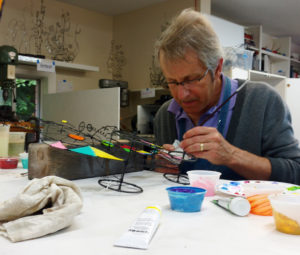 A lot of the essays I’ve been reading lately are saying that the same level of change is about to happen again. All that really fascinates me – but at the core of my art is a desire to show God’s redemptive qualities, and reveal His redemptive nature. I’m hoping to bring a smile to people’s faces, and at the same time cause them to ask deeper questions.
A lot of the essays I’ve been reading lately are saying that the same level of change is about to happen again. All that really fascinates me – but at the core of my art is a desire to show God’s redemptive qualities, and reveal His redemptive nature. I’m hoping to bring a smile to people’s faces, and at the same time cause them to ask deeper questions.
Kolbe Times: James, it’s been wonderful talking with you today. Thank you!
James Paterson: It’s been a real pleasure for me as well.
Be sure to visit James and his prayerful machines at jdpaterson.com
Photos courtesy of James Paterson; video clip courtesy of InnerSpace


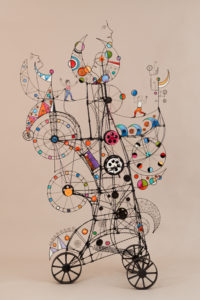
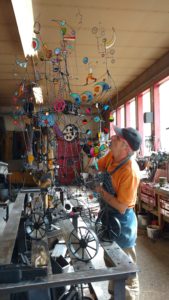
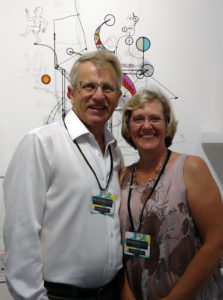
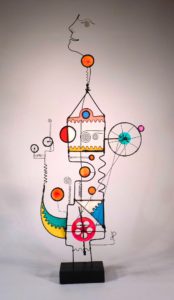
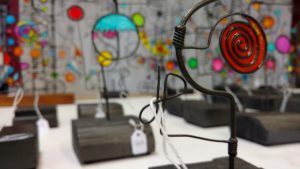
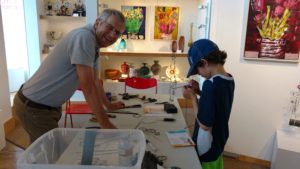
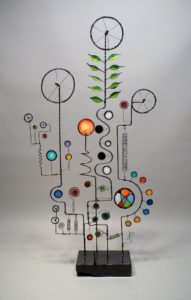






Love your machines, James. Thanks for your work.